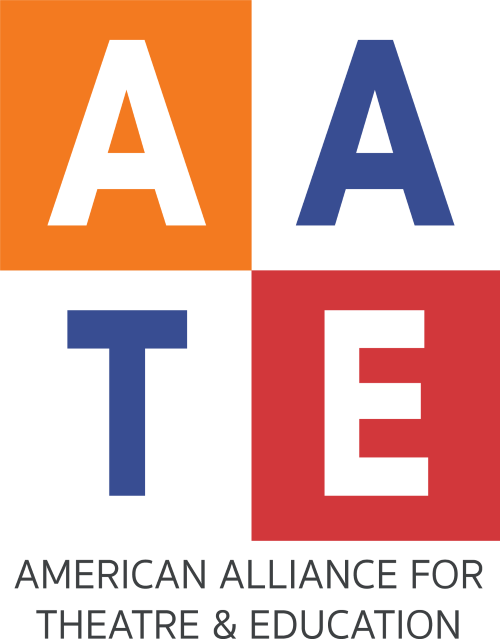- Home
- About AATE
- Membership
- Programs and Events
- Resources
- Networking
- Support AATE
- Online Store
- Contact Us
Grades K-4THE NATIONAL STANDARDS FOR THEATRE EDUCATION*
GRADES K-4
What Every Young American Should Know and Be Able to Do in Theatre
Standards in Theatre, Grades K-4
The standards in this section describe the cumulative skills and knowledge expected of all students upon exiting grade 4. Students in the earlier grades should engage in developmentally appropriate learning experiences to prepare them to achieve these standards at grade 4. Determining curriculum and the specific instructional activities necessary to achieve the standards is the responsibility of states, local school districts, and individual teachers.
THEATRE (K-4)
Theatre, the imagined and enacted world of human beings, is one of the primary ways children learn about life -- about actions and consequences, about customs and beliefs, about others and themselves. They learn through their social pretend play and from hours of viewing television and film. For instance, children use pretend play as a means of making sense of the world; they create situations to play and assume roles; they interact with peers and arrange environments to bring their stories to life; they direct one another to bring order to their drama, and they respond to one another's dramas. In other words, children arrive at school with rudimentary skills as playwrights, actors, designers, directors, and audience members; theatre education should build on this solid foundation. These standards assume that theatre education will start with and have a strong emphasis on improvisation, which is the basis of social pretend play.
In an effort to create a seamless transition from the natural skills of pretend play to the study of theatre, the standards call for instruction that integrates the several aspects of the art form: script writing, acting, designing, directing, researching, comparing art forms, analyzing and critiquing, and understanding contexts. In the kindergarten through fourth grade, the teacher will be actively involved in the students' planning, playing, and evaluating, but students will be guided to develop group skills so that more independence is possible. The content of the drama will develop the students' abilities to express their understanding of their immediate world and broaden their knowledge of other cultures.
Content Standard #1: Script writing by planning and recording improvisations based on personal experience and heritage, imagination, literature, and history
Achievement Standard:
a) Students collaborate to select interrelated characters, environments, and situations for classroom dramatizations
b) Students improvise dialogue to tell stories, and formalize improvisations by writing or recording the dialogue
Content Standard #2: Acting by assuming roles and interacting in improvisations
Achievement Standard:
a) Students imagine and clearly describe characters, their relationships, and their environments
b) Students use variations of locomotor and nonlocomotor movement and vocal pitch, tempo, and tone for different characters
c) Students assume roles that exhibit concentration and contribute to the action of classroom dramatizations based on personal experience and heritage, imagination, literature, and history.
Content Standard #3: Designing by visualizing and arranging environments for classroom dramatizations
Achievement Standard:
a) Students visualize environments and construct designs to communicate locale and mood using visual elements (such as space, color, line, shape, texture) and aural aspects using a variety of sound sources
b) Students collaborate to establish playing spaces for classroom dramatizations and to select and safely organize available materials that suggest scenery, properties, lighting, sound, costumes, and makeup.
Content Standard #4: Directing by planning classroom dramatizations
Achievement Standard:
a) Students collaboratively plan and prepare improvisations and demonstrate various ways of staging classroom dramatizations.
Content Standard #5: Researching by finding information to support classroom dramatizations
Achievement Standard:
a) Students communicate information to peers about people, events, time, and place related to classroom dramatizations.
Content Standard #6: Comparing and connecting art forms by describing theatre, dramatic media (such as film, television, and electronic media), and other art forms
Achievement Standard:
a) Students describe visual, aural, oral, and kinetic elements in theatre, dramatic media, dance, music, and visual arts
b) Students compare how ideas and emotions are expressed in theatre, dramatic media, dance, music, and visual arts
c) Students select movement, music, or visual elements to enhance the mood of a classroom dramatization.
Content Standard #7: Analyzing and explaining personal preferences and constructing meanings from classroom dramatizations and from theatre, film, television, and electronic media productions
Achievement Standard:
a) Students identify and describe the visual, aural, oral, and kinetic elements of classroom dramatizations and dramatic performances
b) Students explain how the wants and needs of characters are similar to and different from their own
c) Students articulate emotional responses to and explain personal preferences about the whole as well as the parts of dramatic performances
d) Students analyze classroom dramatizations and, using appropriate terminology, constructively suggest alternative ideas for dramatizing roles, arranging environments, and developing situations along with means of improving the collaborative processes of planning, playing, responding, and evaluating.
Content Standard #8: Understanding context by recognizing the role of theatre, film, television, and electronic media in daily life
Achievement Standard:
a) Students identify and compare similar characters and situations in stories and dramas from and about various cultures, illustrate with classroom dramatizations, and discuss how theatre reflects life
b) Students identify and compare the various settings and reasons for creating dramas and attending theatre, film, television, and electronic media productions
*The National Standards for Theatre Education were developed by the American Alliance for Theatre and Education in cooperation with the Educational Theatre Association and as part of the National Standards for Arts Education, a product of the Consortium of National Arts Education Associations.
|
